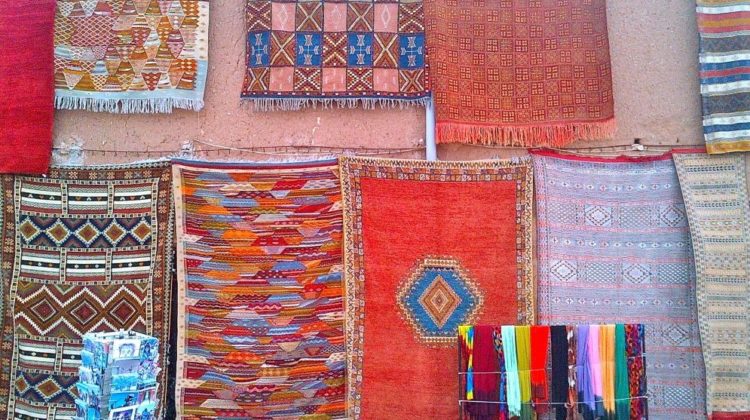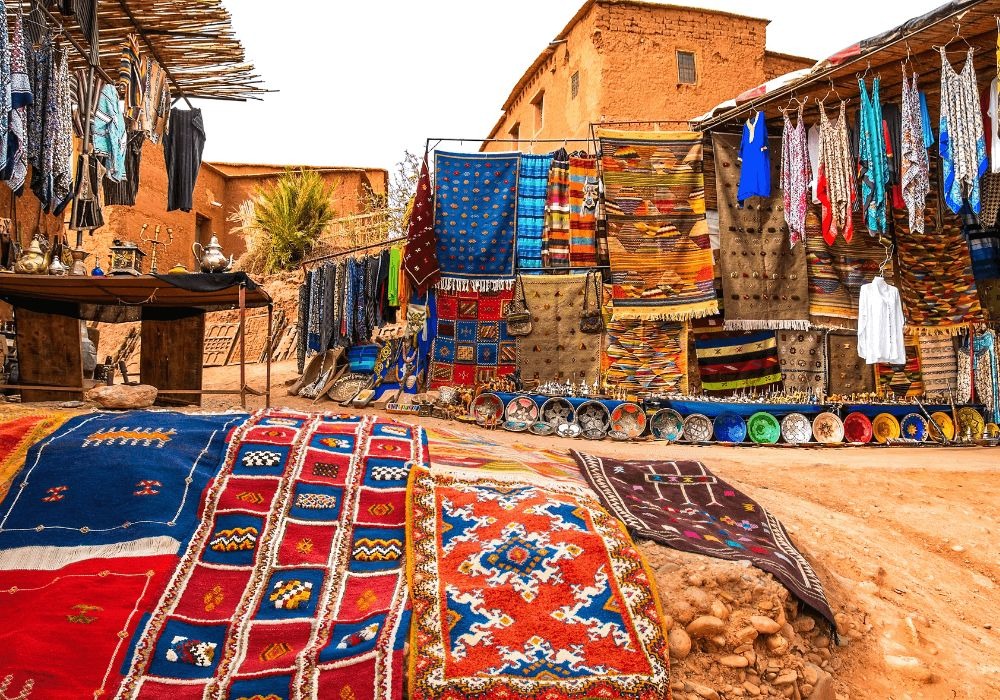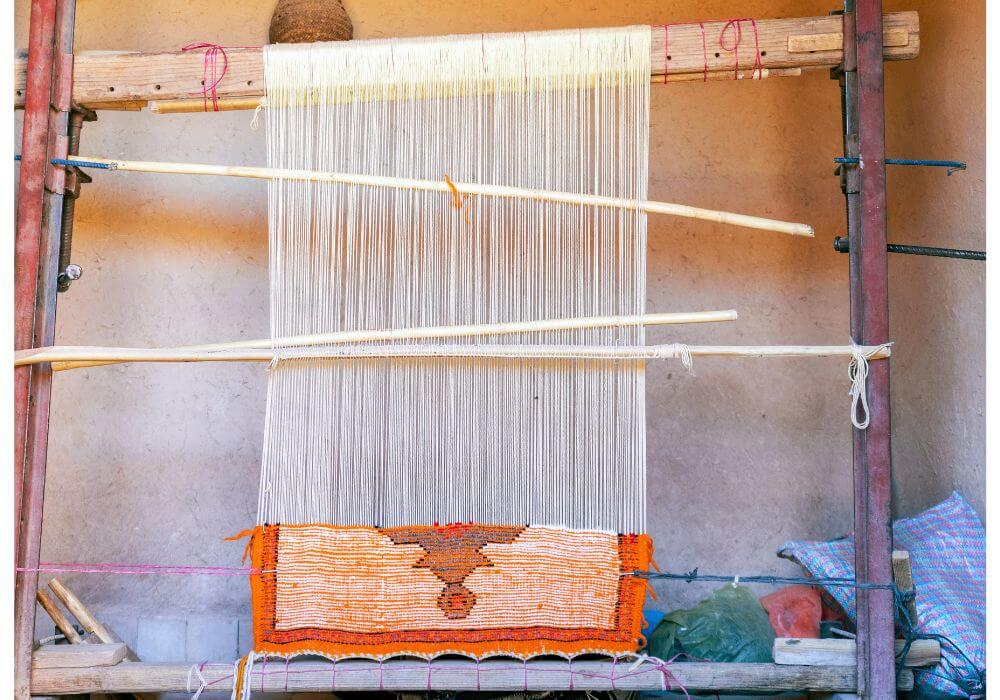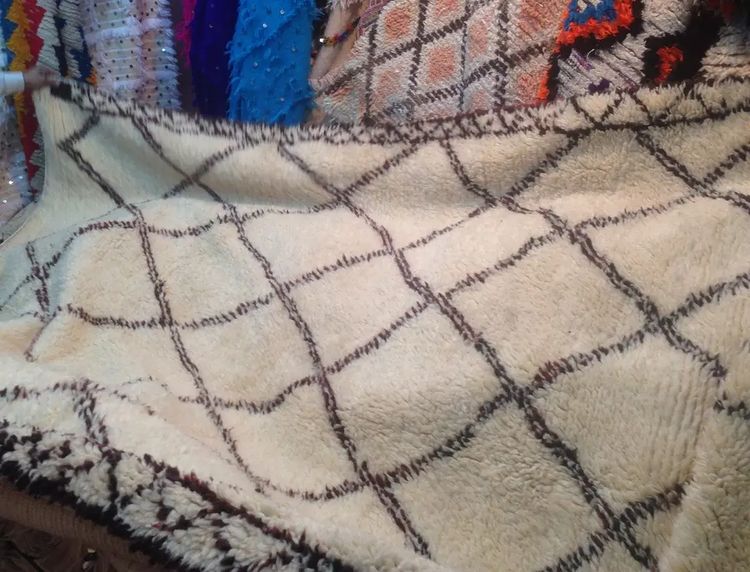
When you think of Moroccan interiors there are certain elements that almost always spring to mind … exquisite tea sets, ornate cushions, stunning lanterns, and striking rugs and carpets, to name just a few.
Rugs and carpets in Morocco may sometimes have a more symbolic significance than simply being used as floor coverings and throws.
Rug-making is bound in age-old traditions and techniques and floor coverings are often a vital feature of any home.
The quality and designs of rugs and carpets may also reflect a home-owners social status and affluence, with home interiors often a bold visual representation of a person’s worth.
It’s not uncommon for people to use the best furniture and rugs in the areas of their homes where they will receive guests.
This is not only to impress guests but, in a land where hospitality is highly valued, often people wish to make their visitors as comfortable as possible.
There is much more to Moroccan rugs and carpets than you may initially think …
Table of Contents
History and Traditions of Moroccan Rugs

Rugs have been produced in Morocco for thousands of years, woven by indigenous peoples for practical purposes such as covering the floor and keeping warm. Indeed, rug-making traditions in Morocco date back to the Paleolithic period.
Moroccan rugs have long been made to suit the diverse climate and conditions, with people living in the Sahara region making thinner, flat rugs while people living in the mountains would usually produce thicker rugs with a heavier pile.
Designs aren’t usually random; weavers follow traditional patterns, and there are usually distinctive styles for different areas and for different Berber groups. Rugs often contain lots of symbolism.
There are also rugs that follow traditional Arab rug-making traditions, brought to the country with the arrival of the early Arabs.
These rugs are found inside many city homes, particularly in the salon (or living area).
Significance of Colors
Saffron, madder root, turmeric, henna, and indigo are the primary dyes used to color the wool. Each color has a different meaning.
Red symbolizes protection and strength. Blue represents wisdom and green stands for peace. Yellow is representative of the everlasting.
Uses of Rugs in Morocco
Although highly detailed and attractive, rugs weren’t traditionally produced for aesthetic purposes in Morocco.
Tribal groups would make rugs to cover the ground inside nomadic shelters and huts, to use as blankets, to wear, as burial shrouds, and as saddle blankets.
Today, rugs are also mass made to fulfill the growing global demand for Moroccan homewares.
However, the rugs that are most sought after are those that were made not for commercial endeavors, but those that were woven by hand by women for personal use in their homes.
Typical Rug-Making Process
Berbers needed looms that were transportable and so they were typically small and fairly basic. Other essential items include combs, cardes, and a spindle.
The first stage of the rug-making process is obtaining the wool. Men shear the sheep with the help of others from the village. The animal is held on its side while ritualistic chants are completed to bring blessings to the fleece.
They then use scissors to shear the sheep.
Women then clean the wool and remove any twigs and other impurities. It’s common for the fleece to be beaten with a stick and then washed in the river before being left to dry underneath the sun. The wool will now either be stored or worked.
Using items called cardes, women turn the wool into yarn. Long fibers are combed. It’s then time to spin the wool using a spindle.
Using a wooden spindle the women create the exact thickness of wool that they require—carpets and blankets use a thicker thread, whereas clothes need a finer thread.
It takes around an hour to build the loom. Once constructed, villagers pay the utmost respect to the loom.
Today, with growing demand, there are a number of weaving centres around Morocco where women work in groups to produce rugs for commercial reasons.

Examples of Rugs Made in Morocco
There are many different types of rugs made in Morocco, with each beautifully crafted piece often showing clearly where it was made through its unique designs, colors, and patterns.
The weaving methods can also tell a lot about where a rug was produced.
Azilal
The Azilal region, which reached from the northern parts of the High Atlas Mountains to the southern foothills of the Middle Atlas Mountains, is known for its striking imagery and symbolism.
Designs are detailed and intricate, made using single knots.
Traditionally, rugs from this region used neutral colors. Today, however, Azilal rugs are known for their bold and bright colors.
Beni Ourain
Beni Ourain is the name given to several tribal groups in the Middle Atlas Mountains.
Beni Ourain rugs are fairly simple in appearance and use raw, un-dyed wool.
The colors are only black, white, and brown. Pile rugs and flat-weave rugs can both be found. The rugs have elegant geometric patterns.
Marmoucha
The Marmoucha tribe comes from the northern Sahara region of Morocco, close to the border with Algeria. Rugs produced here are usually thick and soft with a plush shaggy pile.
Zemmour
Oulmes rugs are made in the Middle Atlas region of Morocco. There are several tribal groups here, including the Zemmour.
Zemmour communities are known for their unique rugs that combine geometric designs with abstract imagery. Red is a common color for rugs made by the Zemmour people.
Zaiane
The Zaiaine tribe would commonly use elongated rhombus shapes (rather like a squashed diamond) in their rug designs.
Rugs were usually shaggy. The tribe is from the southern part of the Middle Atlas region, though they are no longer believed to be weaving rugs. Any genuine Zaiane rug is likely, therefore, to be fairly old.
Ait Bou Ichaouen
Ait Bou Ichaouen rugs are produced close to the Algerian border, to the east of the Atlas Mountains.
Because tribes in this area were generally isolated, there were few outside influences to have an impact on the local rug-making traditions.
Rugs from this area are, therefore, unique. They are unlike other rugs found elsewhere in the Kingdom, and the designs and colors are stunning.
Beni M’guila
Rugs made by the Beni M’guila are beautiful to look at and are also often reversible. The shaggier side is used in the colder winter months, while the flatter side is used in the warmer weather.
Zanafi
Zanafi rugs usually look rather like paintings, with scenes and images woven into the rugs. Local legends tell of a Berber lady who married a European painter and then tried to recreate his art in her rugs.
Tuareg
The Tuareg group was nomadic, and they used mats to furnish their homes, add decoration, and provide warmth. Each time they moved they would roll up their shelters to take with them.
Mats were made from reeds and palm with designs embroidered using leather from goats or camels.
Boucherouite
The word boucherouite comes from the Arabic word that means rag. These rugs are not from a particular area or tribe. Rather, they were invented through economic and social changes.
The rag rugs, which originated in the Central Plains, are made from ripped up pieces of fabric, typically old and worn items of clothing. They are colorful and fun.
Arab Rugs
Arab rugs are often produced in the country’s capital of Rabat and the old imperial city of Fez.
Rugs from Rabat typically have diamond shapes and floral designs. Highly detailed and ornate, they are usually made from sheep’s wool.
Where to Buy Moroccan Rugs
Almost every souk throughout Morocco will have a selection of rugs for sale. You should, however, have some understanding of how to spot a fake rug and know the rough value of genuine items to avoid being scammed.
The medina of Fez is awash with stunning rugs, with fine specimens hanging from walls, draped across tables, and rolled up at the side of stalls. Marrakech’s bustling souks also have numerous rugs for sale.
If you would prefer to shop in relative comfort with less hassle, there are also many specialist carpet shops around the nation.
There are splendid rugs in all colors and patterns to choose between.
The huge Les Nomades de Marrakech is another great choice, with rugs in all sizes and styles and both vintage and contemporary pieces.
Lahandira in Marrakech, also has a wide selection of authentic Berber rugs.
In Fez, check out Coin Berbere in the heart of the medina. You’ll find a veritable treasure trove of carpet delights.
Flat-Weave Rugs Versus Pile Rugs
Flat-weave rugs (sometimes also referred to as kilims) are those that are not knotted.
Patterns are created through the use of different colors, with threads intertwined with the weft and then changed depending on the desired color.
Pile rugs are softer and thicker, created by numerous knots around the weft.
Sometimes, patterns aren’t immediately apparent in such rugs—as the pile wears down over time the pattern will appear, somewhat mystically.
